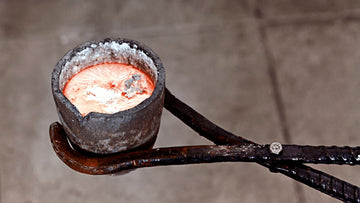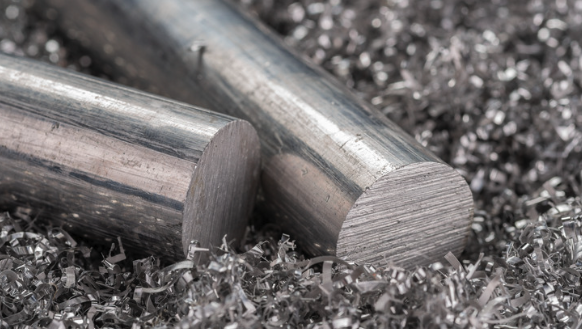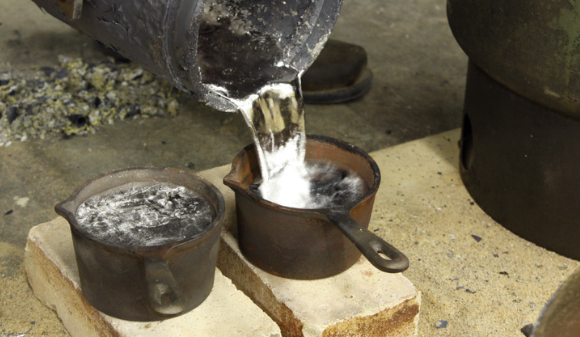
Understanding when aluminum melts is really important for different kinds of welding work. Lots of people use aluminum in building things, making cars, and even in planes because it's light and doesn't rust easily.
When you're welding aluminum, you've got to be careful with how hot you get it. Knowing the exact temperature at which aluminum starts to melt is super important. This helps you not to mess up the shape of the metal or cause it to crack while you're working on it.
In this guide, we'll go over the temperature aluminum melts at, how to control your welder's heat, and give you clear advice for welding aluminum the right way.
Getting this right matters a lot, whether you're just starting or you've been welding for a while. Let's make sure you've got the know-how to handle aluminum on your next project.
What Temperature Does Aluminum Melt?
The melting point of aluminum is approximately 660 degrees Celsius or 1220 degrees Fahrenheit. This means that aluminum will start to liquefy at this temperature and become a molten liquid that can be poured or molded into different shapes.
One of the key properties of aluminum is its melting point, which determines how it can be processed and shaped.
It is important to note that the melting point of aluminum can vary depending on the specific alloy and impurities present in the metal. For example, some aluminum alloys may have a slightly higher or lower melting point than pure aluminum. Additionally, impurities such as silicon, magnesium, and copper can affect the melting point of aluminum.
In general, aluminum has a relatively low melting point compared to other metals such as steel and copper. This makes it easier to work with and process, as it requires less energy and heat to melt. However, it also means that aluminum is not as strong or durable as these other metals and may not be suitable for certain applications.
Understanding Aluminum Alloys in Welding

When it comes to welding aluminum, it's important to understand the different types of aluminum alloys that exist. Aluminum alloys are made up of a combination of aluminum and other metals, which can significantly affect their melting temperature and other properties.
For example, the melting point of aluminum can range from about 600 to 1220°F depending on the alloy composition. As a result, different aluminum alloys may require different welding techniques and temperatures.
Ensure a Successful Weld
For a good weld, you need to pick the right filler metal that melts at about the same temperature as the aluminum you're welding. This stops weak spots from showing up in the weld.
Some common aluminum alloys used in welding include 6061-T6, 5052-H32, and 4043. Each of these alloys has its own unique properties that make it suitable for different applications. For instance, 6061-T6 is a popular alloy for structural applications due to its high strength, while 5052-H32 is often used for marine and transportation applications due to its corrosion resistance.
In addition to melting temperature, other factors to consider when welding aluminum alloys include the thickness of the material, the joint design, and the welding process being used.
For instance, TIG welding is often preferred for thinner materials, while MIG welding is better suited for thicker materials.
Factors Influencing Aluminum's Melting Temperature in Welding

When you're welding aluminum, a few things can change how quickly it melts.
Check out stuff like:
- What's in the Aluminum: The mix of metals in the aluminum alloy can make a difference. Some combos melt at different temperatures than others.
- How Thick It Is: Thicker pieces of aluminum take longer to heat up and melt than thinner ones.
- How You Weld: The way you weld, like using TIG or MIG methods, can also play a part in how hot the aluminum gets and when it starts to melt.
Knowing these things can help you weld better by keeping the heat just right.
Alloy Composition
Aluminum alloys are composed of different elements that can affect their melting temperature. For example, 6061-T6 aluminum alloy has a melting temperature of around 585°C (1085°F), while 7075 aluminum alloy has a melting temperature of around 640°C (1184°F). The presence of other elements such as magnesium, copper, and silicon can also affect the melting temperature of aluminum alloys.
Therefore, it is important to know the exact composition of the aluminum alloy being welded to determine its melting temperature.
Thickness of Aluminum
The thickness of the aluminum being welded can also affect its melting temperature. Thicker aluminum requires more heat to melt, while thinner aluminum requires less heat. Therefore, it is important to adjust the welding parameters to match the thickness of the aluminum being welded.
Welding Technique
The welding technique used can also affect the melting temperature of aluminum. For example, TIG welding requires a higher heat input than MIG welding. Therefore, TIG welding can result in a higher melting temperature than MIG welding.
Additionally, the speed of the welding process can also affect the melting temperature. A slower welding speed can result in a higher melting temperature, while a faster welding speed can result in a lower melting temperature.
Check out our collection of Aluminum Welders!
How to Measure and Control Temperature When Welding Aluminum
Welding aluminum requires precise temperature control to ensure successful welds. Overheating can cause distortion, cracking, or even complete failure of the weld. On the other hand, if the temperature is too low, the weld may not penetrate the base material properly, leading to weak joints. Therefore, it's essential to measure and control temperature during welding to achieve optimal results. Here are some practical tips for measuring and controlling temperature when welding aluminum.
Use a Non-Contact Infrared Thermometer
One of the easiest and most accurate ways to measure the temperature of aluminum during welding is to use a non-contact infrared thermometer. This tool measures the temperature of the material without touching it, allowing you to get accurate readings without interfering with the welding process. When using an infrared thermometer, aim it at the area you want to measure and hold the trigger until you get a reading.
Monitor the Welding Current
The welding current is another critical factor that affects the temperature of the aluminum during welding. When the current is too high, the material can overheat, leading to weak joints. Conversely, if the current is too low, the weld may not penetrate the base material properly. Therefore, it's essential to monitor the welding current and adjust it as needed to maintain the optimal temperature.
Preheat the Material
Preheating the aluminum material before welding can help to reduce the risk of overheating and ensure a successful weld. Preheating the material raises its temperature, making it easier to weld and reducing the risk of cracking or distortion. The preheating temperature will depend on the thickness of the material and the welding method used. Consult the manufacturer's guidelines or a welding expert to determine the appropriate preheating temperature for your specific application.
Use a Temperature Control System
If you're doing a large or complex welding project, it may be worth investing in a temperature control system. These systems use sensors to monitor the temperature of the material and adjust the welding parameters automatically to maintain the optimal temperature. Temperature control systems can be expensive, but they can save you time and money in the long run by reducing the risk of failed welds and rework.
Heating and Melting During Aluminum Fabrication
When you're working with aluminum, it's super important to know how hot it needs to get before it melts. This helps a lot when you're making stuff with it.
Aluminum starts to melt at about 660°C, which is the same as 1220°F. But, this can change a bit depending on what's mixed with the aluminum. When you mix in other stuff like magnesium or silicon, it can actually make the aluminum melt at a lower temperature.
Aluminum Fabrication and Processing
During aluminum fabrication, the metal is heated to a temperature that is high enough to make it pliable and malleable. This temperature is typically below the melting point of the aluminum, and it can vary depending on the specific application and alloy being used. Heating aluminum to the correct temperature is critical for ensuring that the metal can be manipulated without cracking or breaking.
One common method of heating aluminum during fabrication is through the use of a furnace or oven. The aluminum is placed in the oven and heated to the desired temperature. Once the metal has reached the correct temperature, it can be removed from the oven and worked into the desired shape.
Another method of heating aluminum is through the use of a torch. A torch can be used to heat specific areas of the metal, allowing for precise manipulation. This method requires a skilled operator to ensure that the aluminum is not overheated or damaged during the process.
In addition to heating, the cooling process is also important during aluminum fabrication. Cooling the metal too quickly can cause it to become brittle and crack. To avoid this, the metal is typically allowed to cool slowly, either by air cooling or by placing it in a cooling chamber.
Safety Tips for Welding Aluminum
Welding aluminum requires taking safety precautions to protect yourself from hazards that may arise during the process.
Here are some safety tips to keep in mind while welding aluminum:
Wear Protective Clothing
When you're welding aluminum, it's super important to dress right to keep yourself safe. You need to wear a welding helmet, gloves, and an apron. These keep your eyes, face, hands, and body safe from sparks, bright light, and heat.
Also, make sure to wear clothes made from stuff like cotton. Why? Because if something goes wrong, synthetic fabrics can melt and stick to your skin, and that's something we definitely want to avoid.
Read Related Article: Welding Eye Injury Prevention: Tips and Best Practices
Use Proper Ventilation
Welding aluminum produces fumes and gases that can be harmful when inhaled. Therefore, it is crucial to use proper ventilation to remove fumes and gases from the welding area. This can be achieved by using an exhaust hood or a fan to blow the fumes and gases away from you.
Prepare the Welding Area
Before welding aluminum, it is essential to prepare the welding area to prevent accidents. This includes removing any flammable materials, cleaning the area, and ensuring that there is no moisture or oil on the surface to be welded. Additionally, keep a fire extinguisher nearby in case of a fire.
Use the Right Equipment
Using the right equipment is critical when welding aluminum. Ensure that you use an aluminum-specific MIG welding machine, which has a spool gun to feed the aluminum wire. Also, use the correct filler rod and electrode to ensure that the welds are strong and durable.
Avoid Overheating
Overheating the aluminum during welding can cause it to melt and deform. Therefore, it is essential to control the heat input to prevent overheating. Use a lower voltage and amperage setting to reduce the heat input and prevent the aluminum from melting.
Troubleshooting Common Aluminum Welding Temperature Issues
When you're welding aluminum, getting the temperature just right is super important. If the temperature's not spot on, you can run into problems like holes forming in the weld, cracks popping up, or the weld not being as strong as it should be.
Here are some typical problems that might arise from incorrect temperature settings during aluminum welding and how to solve them:
Porosity
Porosity is a common issue that occurs when there are gas pockets in the weld. This is often caused by incorrect temperature settings. If the temperature is too low, the weld may not penetrate the base material properly, resulting in gas pockets. If the temperature is too high, the aluminum may oxidize, creating gas pockets.
How to Prevent Porosity
To solve this issue, ensure that you are using the correct temperature settings for the specific aluminum alloy you are welding. Refer to the manufacturer's guidelines for recommended temperature settings. Additionally, make sure that your welding area is clean and free of any contaminants that could cause porosity.
Cracking
Cracking can occur when the aluminum cools too quickly after welding. This is often caused by incorrect temperature settings or improper preheating. If the temperature is too low, the weld may not penetrate the base material enough, resulting in weak spots that can crack. If the temperature is too high, the aluminum may cool too quickly, causing it to shrink and crack.
How to Prevent Cracking
To solve this issue, ensure that you are using the correct temperature settings for the specific aluminum alloy you are welding. Additionally, make sure that you are preheating the aluminum properly before welding. Preheating can help prevent cracking by ensuring that the aluminum cools slowly and evenly.
Weakened Welds
Weakened welds can occur when the temperature is too high or too low. If the temperature is too low, the weld may not penetrate the base material enough, resulting in weak spots. If the temperature is too high, the aluminum may become weakened due to excessive heat.
How to Prevent Weekend Welds
To solve this issue, ensure that you are using the correct temperature settings for the specific aluminum alloy you are welding. Additionally, make sure that you are using the correct welding technique and that you are not applying too much heat to the aluminum.
Conclusion
Wrapping it up, getting the melting point of aluminum right is key in welding. You don't want to weld too hot and mess up the metal. The best way to weld aluminum is to use TIG welding because it gives you really good welds.
Also, match your welding filler to the aluminum, and keep everything clean so your weld isn't dirty. Remember, different aluminum mixes melt at different heats—pure aluminum melts around 1220°F, but other kinds can melt as low as 600°F.
So, you've got to know exactly what type of aluminum you've got and the heat it melts at to get your welding just right.
Frequently Asked Questions
What temperature does aluminum melt at Celsius?
Aluminum has a melting point of 660.32°C (1218°F) in its purest form under normal atmospheric pressure. However, the melting point of aluminum can vary depending on the alloy.
What is the easiest metal to melt?
The easiest metal to melt is tin, which has a melting point of only 231.9°C (449.4°F).
At what temperature does aluminum melt in welding?
The temperature at which aluminum melts during welding depends on the type of aluminum and the welding process used. Generally, aluminum melts at a temperature range of 577-632°C (1070-1170°F) during welding.
Is aluminum hotter than steel?
Aluminum has a lower melting point than steel, so it can be considered "hotter" in terms of melting temperature. However, steel has a higher boiling point than aluminum.
